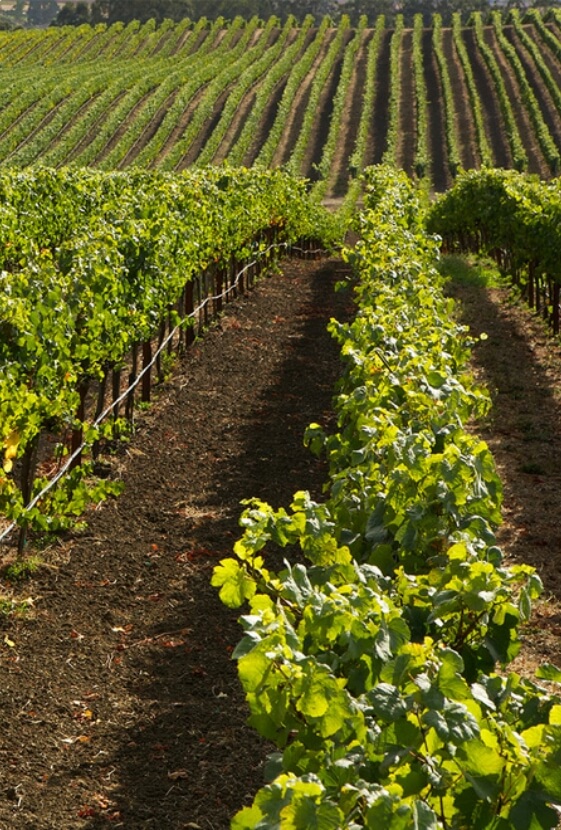Both La Forra and the Chianti Classico Riserva are produced from the superb La Forra parcel, the estate’s finest vineyard, situated on a southerly-exposed slope at an altitude of 900 feet. The single-vineyard wine La Forra is made only in exceptional vintages.
Archives: Vineyards
description
La Terre Promise
Domaine Carneros’ newest vineyard, La Terre Promise, was planted beginning in 2002. Its 117 acres are planted 80% to Pinot Noir and 20% to Chardonnay. La Terre Promise possesses the steepest vineyard slopes and most varied exposures of the four estate vineyards. Its fruit contributes to the blend of both the sparkling and still wines.
Pompadour Vineyard
An important development in the source of Domaine Carneros’ fruit came in 1991 with the acquisition of the Pompadour Vineyard, situated on the western side of the Carneros appellation. This vineyard consists of 58 acres of Chardonnay and Pinot Noir vines first planted in 1991 on dense clay, clay loam and sandy soils with a gently sloping topography. The Pompadour vineyard contributes to the blend of both the sparkling and still wines.
Domaine Carneros Estate Vineyard
The Domaine Carneros Estate Vineyard, first planted in 1981, extends up a slope rising to a crest overlooking San Francisco and San Pablo Bay, with an elevation of 120 to 260 feet above sea level. Its superb mesoclimate, characterized by a long, cool growing season tempered by the maritime breezes and persistent fogs of the coast, is the perfect environment for the classic Chardonnay and Pinot Noir varieties of Champagne. The Estate Vineyard primarily contributes to the sparkling wine cuvées.
Te Muna Road Vineyard
The Te Muna Road Vineyard is located roughly five miles from the center of the town of Martinborough, and is divided into two terraces. The upper terrace lies entirely on the old, stony, decomposing Martinborough terrace soils that have become famous for Pinot Noir. As might be expected, this terrace is planted primarily to Pinot Noir and Chardonnay on proven rootstocks and, where possible, in new clones from Burgundy. The lower terrace is geologically distinct, dominated by greywacke stones interspersed with a little limestone, and is planted almost entirely to Sauvignon Blanc. The vineyard architecture is a very intensive, narrow-row structure with between 1,400 and 2,100 vines per acre.
Kidnappers Vineyard
Kidnappers Vineyard is located at Cape Kidnappers on the Hawkes Bay coastline, where spring and autumn are warm and sunny and the summer is tempered by the cooling sea breeze. The shallow, warm clay loam soils and careful selection of clones in this environment allow the development of very pure, cool flavors in the Chardonnay grown there.
Gimblett Gravels Vineyard
Within Hawke’s Bay there are pockets of austere, gravelly soil perfectly suited to Bordeaux varieties. Gimblett Gravels, an 850-hectare region, is the warmest vineyard area in the country. Average summer temperatures are only a degree or two cooler than Napa’s Oakville district. The warmth is enhanced by rock beds over 90 feet deep which act as incubators at night, releasing heat absorbed from the sun during the day. The effect is a terroir in which Cabernet, and particularly Merlot, consistently achieve a level of ripeness seldom attainable elsewhere in New Zealand.
In the Gimblett Gravels region, Craggy Range has carved out the 100-hectare Gimblett Gravels Vineyard for red and white Bordeaux varieties and Syrah. The narrow-row vine architecture is planted to a very intensive density of between 1,400 and 2,100 vines per acre, with several plots trained low to the ground to benefit completely from the thermal conductivity and reflectiveness of the soils. Extensive deep soil preparations encourage deeply rooted vines to reach veins of sand, silt and clay immersed far into the gravel, and drip irrigation is applied only when required. Thirty-six varietal plots have been matched to the variations in depth and texture of the gravelly soils of the meandering old stream beds of the Ngaruroro River.
a
Dancing Bear Ranch Vineyard
Acquired in 1999, Dancing Bear Ranch consists of 28 vineyard acres on Howell Mountain in northern Napa Valley, from which a single-vineyard red wine is produced. The vines are rooted into shallow, rocky soils at 1,450 to over 1,600 feet above sea level. With its near 360-degree exposure, the site offers a wide range of growing conditions.
